The Anti-Static Hair Care Products Market is expected to record a valuation of USD 2,306.5 million in 2025 and USD 5,306.7 million in 2035, reflecting an absolute increase of USD 3,000.2 million, equivalent to a 193% rise over the decade. The overall expansion represents a CAGR of 8.7%, translating to nearly a 2.3x increase in global market size.
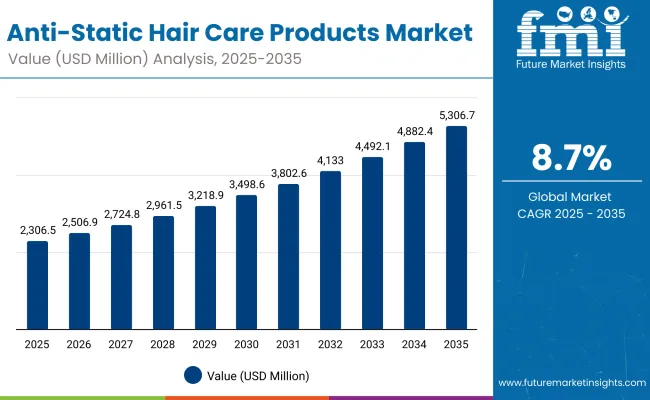
Anti-Static Hair Care Products Market Key Takeaways
| Metric | Value |
|---|---|
| Anti-Static Hair Care Products Market Estimated Value (2025E) | USD 2,306.5 million |
| Anti-Static Hair Care Products Market Forecast Value (2035F) | USD 5,306.7 million |
| Forecast CAGR (2025 to 2035) | 8.7% |
During the first five-year period from 2025 to 2030, the market expands from USD 2,306.5 million to USD 3,498.6 million, adding USD 1,192.1 million, which accounts for approximately 40% of the total decade growth. This stage reflects consistent consumer adoption of leave-in conditioners and anti-frizz serums, driven by heightened demand for daily-use formulations and professional salon-grade results. Fine and thin hair care products dominate this phase with a 38.1% segment share, as lightweight, non-greasy silicone-based formulations gain traction.
The second half from 2030 to 2035 contributes an additional USD 1,808.1 million, equal to around 60% of total decade growth, as the market rises from USD 3,498.6 million to USD 5,306.7 million. This acceleration is powered by increasing integration of botanical oils, protein complexes, and quaternary compounds in advanced formulations tailored for curly and color-treated hair. Argan oil-based products expand faster in this phase, supported by premiumization trends and e-commerce retail growth. Moreover, China, India, and Japan emerge as key growth engines, collectively recording double-digit CAGR through 2035.
From 2020 to 2024, the Anti-Static Hair Care Products Market expanded steadily, led by silicone and quaternary compound-based formulations offering enhanced smoothness and frizz resistance. During this period, leading brands accounted for nearly USD 1,400-1,500 million, representing about 60-65% of total revenue. Companies such as Living Proof, L’Oréal Professional, and Moroccanoil strengthened their foothold through professional salon partnerships and hybrid distribution models.
In 2025, market demand is projected at USD 2,306.5 million, rising to USD 5,306.7 million by 2035, reflecting an absolute growth of USD 3,000.2 million. The surge is driven by the expanding influence of botanical oils, protein complexes, and argan-infused conditioners. Premiumization and e-commerce-led personalization are reshaping competitive advantage, with emerging digital-native brands focusing on sustainability, ingredient transparency, and recurring subscription-based consumer engagement.
The Anti-Static Hair Care Products Market is expanding as consumers seek solutions to manage frizz, static buildup, and dryness caused by increased exposure to heat styling and environmental humidity. Silicone- and quaternary-based leave-in conditioners, serums, and sprays are becoming essential in daily haircare routines. The shift toward lightweight, multifunctional formulations that offer smoothness without residue has driven adoption across both professional and retail segments, reinforcing steady demand across premium and mass-market categories worldwide.
Market growth is further accelerated by rising e-commerce penetration and consumer preference for natural, botanical, and argan oil-based formulations. Online platforms have enabled niche and clean-beauty brands to reach global audiences with targeted anti-static solutions. Simultaneously, the premiumization trend emphasizing high-performance ingredients and personalized care is strengthening brand differentiation. Consumers increasingly value sustainable, cruelty-free, and dermatologist-tested products, driving continuous innovation and supporting long-term category expansion across emerging markets in Asia-Pacific and mature markets in North America and Europe.
The Anti-Static Hair Care Products Market is segmented by product type, key ingredients, hair type, distribution channel, end user, and region. Product types include leave-in conditioners, anti-frizz serums, static-control sprays, and moisturizing shampoos & conditioners, which collectively shape the category’s core demand structure. By key ingredients, the market is divided into silicones and quaternary ammonium compounds, argan and botanical oils, and protein complexes, reflecting the balance between performance chemistry and natural formulations. Based on hair type, segmentation covers fine & thin, curly & wavy, and color-treated hair, addressing texture-specific care needs.
By distribution channel, the market includes salons and professional stores, e-commerce, supermarkets & hypermarkets, and pharmacies, each catering to distinct consumer accessibility models. End users are segmented into women, men, and unisex, with women remaining the largest demographic. Regionally, the market spans North America, Europe, East Asia, South Asia & Pacific, Latin America, and the Middle East & Africa, with Asia-Pacific emerging as the fastest-growing hub driven by rapid adoption in China, India, and Japan.
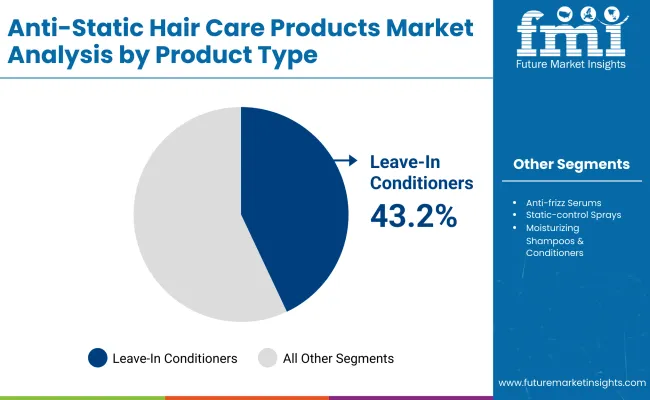
| Product Type | Value Share% 2025 |
|---|---|
| Leave-in conditioners | 43.2% |
| Others | 56.8% |
The leave-in conditioners segment is projected to contribute 43.2% of the Anti-Static Hair Care Products Market revenue in 2025, maintaining its lead as the dominant product category. Growth is driven by rising consumer preference for lightweight, non-rinse formulations that provide prolonged anti-frizz protection and moisture retention. These products cater to busy lifestyles and are widely favored for their convenience and effectiveness across diverse hair types.
The segment’s expansion is further supported by the integration of silicone and quaternary ammonium compounds that neutralize static charges and smoothen hair cuticles. Continuous innovation in multi-benefit formulations combining hydration, heat protection, and styling support enhances market competitiveness. As premium and salon-grade brands expand their presence through e-commerce channels, leave-in conditioners are expected to remain the core revenue contributor and backbone of the anti-static hair care product portfolio through 2035.
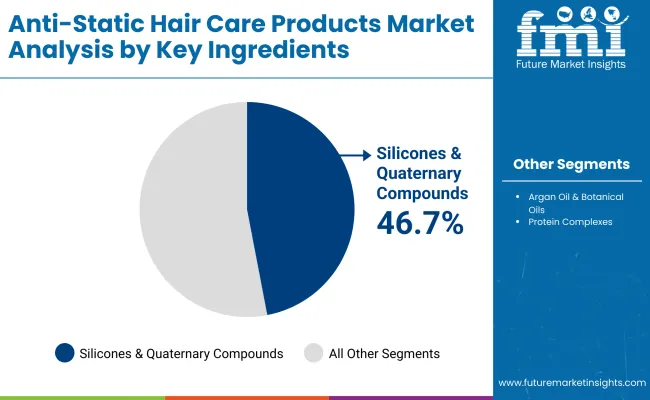
| Key Ingredients | Value Share% 2025 |
|---|---|
| Silicones & quaternary compounds | 46.7% |
| Others | 53.3% |
The silicones and quaternary compounds segment is projected to hold 46.7% of the Anti-Static Hair Care Products Market revenue in 2025, driven by their proven effectiveness in neutralizing surface charge and improving hair smoothness. These ingredients are preferred for their ability to form protective films that reduce friction, prevent flyaways, and enhance manageability key concerns for consumers in humid and dry environments alike.
Their versatility and compatibility with multiple formulations, including leave-in conditioners, serums, and sprays, have supported mass adoption across both professional and retail lines. Growth is further boosted by technological advancements in conditioning polymer design, which deliver lasting softness without buildup. As consumers increasingly prioritize performance and long-term scalp health, silicones and quaternary blends are expected to retain their dominance as the foundation of high-performance anti-static formulations through 2035.
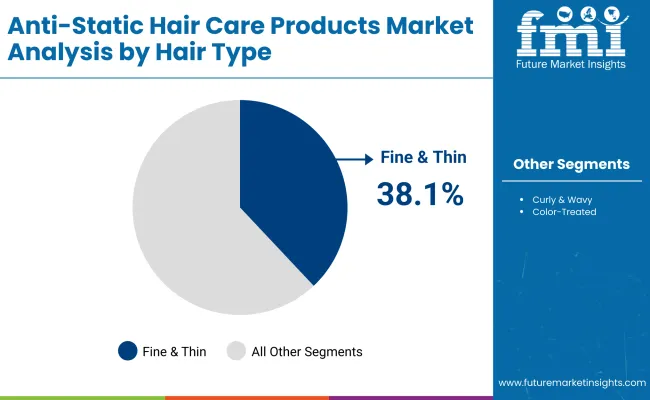
| Hair Type | Value Share% 2025 |
|---|---|
| Fine & thin | 38.1% |
| Others | 61.9% |
The fine & thin hair segment is projected to account for 38.1% of the Anti-Static Hair Care Products Market revenue in 2025, positioning it as a key focus area for manufacturers. Products targeting this hair type emphasize lightweight, volumizing, and anti-frizz properties, ensuring smoothness without weighing down delicate strands. Consumers with fine hair are particularly sensitive to static buildup caused by dry air and synthetic fibers, driving consistent demand for gentle, conditioning solutions.
The segment’s growth is fueled by advancements in silicone-based micro-conditioning agents and cationic polymers that provide anti-static benefits while preserving natural volume. Additionally, the popularity of leave-in conditioners and lightweight sprays designed for thin hair textures has enhanced product accessibility across online and retail channels. As personalization trends expand and ingredient innovation continues, fine & thin hair formulations are expected to maintain their leadership in the anti-static care category through 2035.
Increasing Consumer Awareness of Hair Damage and Static Control
Rising consumer focus on hair health and manageability is a major growth driver for the Anti-Static Hair Care Products Market. Exposure to pollution, heat styling, and chemical treatments has amplified the need for products that reduce static buildup and frizz while restoring smoothness. Consumers are increasingly seeking daily-use solutions such as leave-in conditioners and anti-frizz serums enriched with silicones, argan oil, and botanical extracts. This awareness, coupled with expanding access to premium and dermatologist-tested brands, continues to fuel consistent demand across both professional salon and retail distribution channels worldwide.
Expansion of E-Commerce and Premium Product Accessibility
The rapid expansion of online retail platforms has transformed consumer accessibility to specialized anti-static hair care solutions. E-commerce allows global reach for niche and premium brands, enabling consumers to discover innovative formulations tailored to individual hair concerns. Subscription-based models and digital personalization tools are enhancing repeat purchase behavior. Moreover, increasing consumer willingness to spend on clean, sulfate-free, and cruelty-free anti-static formulations supports premiumization trends. The combination of convenience, variety, and data-driven marketing strategies positions e-commerce as a central channel propelling sustained growth in the anti-static hair care category.
High Product Cost and Ingredient Sensitivity Concerns
Despite strong market momentum, product affordability and ingredient-related sensitivity issues pose challenges. Premium anti-static hair care products often rely on costly silicone derivatives, conditioning polymers, and botanical oils, which elevate retail prices. This limits penetration in price-sensitive markets, particularly in developing regions. Additionally, consumer concern regarding long-term silicone buildup, scalp irritation, and sustainability of synthetic ingredients has prompted cautious purchasing behavior. These factors may restrain growth in lower-income demographics, compelling manufacturers to develop cost-efficient, transparent, and dermatologist-verified formulations to sustain consumer confidence and brand loyalty.
Rising Shift Toward Botanical and Clean-Label Formulations
A notable market trend is the transition toward clean-label and naturally derived anti-static hair care formulations. Brands are increasingly replacing traditional silicones and quaternary compounds with plant-based alternatives such as argan oil, coconut oil, and hydrolyzed proteins. This aligns with the growing consumer preference for environmentally safe, vegan, and biodegradable products. Transparency in ingredient sourcing and claims of "silicone-free" or "paraben-free" products have become strong differentiators in premium segments. As sustainability and health consciousness gain traction, clean-beauty positioning is redefining the product innovation roadmap for anti-static hair care manufacturers globally.
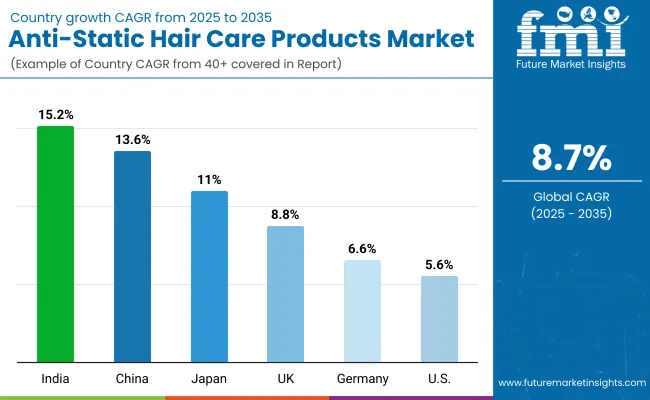
| Countries | Estimated CAGR (2025 to 2035) |
|---|---|
| China | 13.6% |
| USA | 5.6% |
| India | 15.2% |
| UK | 8.8% |
| Germany | 6.6% |
| Japan | 11.0% |
The global Anti-Static Hair Care Products Market demonstrates significant regional variation in growth momentum, primarily driven by climate diversity, consumer spending patterns, and evolving beauty standards. Asia-Pacific emerges as the fastest-growing region, led by India (15.2%) and China (13.6%), fueled by rising disposable incomes, rapid urbanization, and growing consumer awareness of frizz and static-control benefits. India’s expansion reflects surging e-commerce sales, influencer-driven beauty marketing, and increasing availability of affordable silicone-free, argan oil-based formulations. China’s growth is anchored by premium salon adoption, domestic brand innovation, and heightened interest in natural anti-static ingredients.
Japan (11.0%) maintains steady growth through advanced cosmetic R&D and aging population-driven demand for scalp-friendly formulations. In Europe, the UK (8.8%) and Germany (6.6%) sustain strong performance due to consumer preference for clean-label and dermatologically tested products, supported by regulatory focus on product safety. North America, led by the USA (5.6%), remains a mature but stable market where premium and professional salon-grade brands dominate, and personalization trends through digital platforms continue to shape competitive differentiation. Collectively, these regional patterns illustrate a global transition toward high-performance, sustainable, and technology-infused hair care solutions.
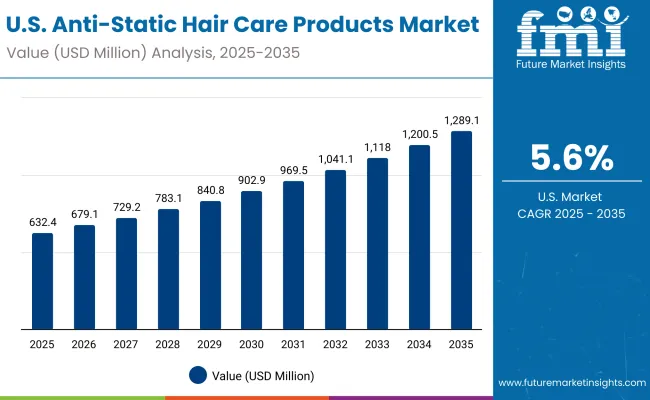
| Year | USA Anti-Static Hair Care Products Market (USD Million) |
|---|---|
| 2025 | 632.41 |
| 2026 | 679.09 |
| 2027 | 729.22 |
| 2028 | 783.05 |
| 2029 | 840.86 |
| 2030 | 902.93 |
| 2031 | 969.58 |
| 2032 | 1041.16 |
| 2033 | 1118.02 |
| 2034 | 1200.55 |
| 2035 | 1289.17 |
The Anti-Static Hair Care Products Market in the United States is projected to grow at a CAGR of 7.8% between 2025 and 2035, reflecting consistent consumer adoption and product diversification. Growth is driven by increasing preference for leave-in conditioners and serums formulated with silicones, quaternary compounds, and botanical blends that combat frizz and static buildup caused by frequent styling and dry climatic conditions.
Rising consumer inclination toward premium, salon-grade, and sulfate-free products has strengthened the dominance of professional haircare brands in retail and e-commerce channels. Furthermore, digital personalization tools and subscription-based product lines are enhancing repeat purchases and brand loyalty. The USA market’s maturity is characterized by stable pricing, high product quality expectations, and rapid innovation cycles centered on clean-label, cruelty-free, and scalp-friendly formulations.
The Anti-Static Hair Care Products Market in the United Kingdom is expected to grow at a CAGR of 8.8% between 2025 and 2035, supported by a strong shift toward clean-beauty formulations, sustainable packaging, and premium haircare innovations. Demand is driven by consumers seeking lightweight, non-greasy solutions for static control, particularly in cold and dry climates where frizz management remains a key concern. The market also benefits from heightened awareness of hair health, fueled by salon education programs and influencer campaigns promoting anti-static routines.
Leading UK brands and retailers are integrating botanical oils, silicone alternatives, and cationic conditioning agents into new product lines, aligning with regulatory emphasis on eco-friendly ingredients and recyclability. Additionally, partnerships between cosmetic laboratories, dermatology institutions, and universities are fostering product innovation centered on scalp microbiome balance and allergen-free formulations.
India is witnessing rapid expansion in the Anti-Static Hair Care Products Market, projected to grow at a CAGR of 15.2% through 2035. Growth is being driven by increasing consumer awareness, expanding middle-class purchasing power, and wider retail access to premium and affordable anti-frizz solutions. Rising humidity and pollution levels across urban centers have amplified the demand for silicone-based and botanical formulations that protect hair from static buildup, dryness, and damage.
The proliferation of e-commerce platforms and beauty-focused marketplaces has made international and domestic brands more accessible in tier-2 and tier-3 cities. Local manufacturers are introducing cost-effective, climate-adapted products containing argan oil, coconut derivatives, and cationic conditioners tailored to regional hair types. Meanwhile, collaborations between salons and cosmetic chemists are promoting professional anti-static treatments across India’s urban grooming sector.
The Anti-Static Hair Care Products Market in China is expected to grow at a CAGR of 13.6%, the highest among leading global economies. This robust expansion is driven by rising consumer awareness, urban lifestyle shifts, and a strong preference for premium anti-frizz formulations. Rapid economic growth and increasing beauty consciousness among younger consumers are encouraging the adoption of leave-in conditioners, serums, and sprays that combine silicone and botanical oil complexes for superior hair manageability.
Domestic brands are rapidly scaling their product portfolios with affordable yet high-performance anti-static solutions, while international companies are strengthening market presence through collaborations with digital retail platforms such as Tmall and JD.com. China’s evolving clean-beauty ecosystem, supported by government initiatives promoting sustainable cosmetics manufacturing, continues to fuel innovation in paraben-free and eco-certified formulations.
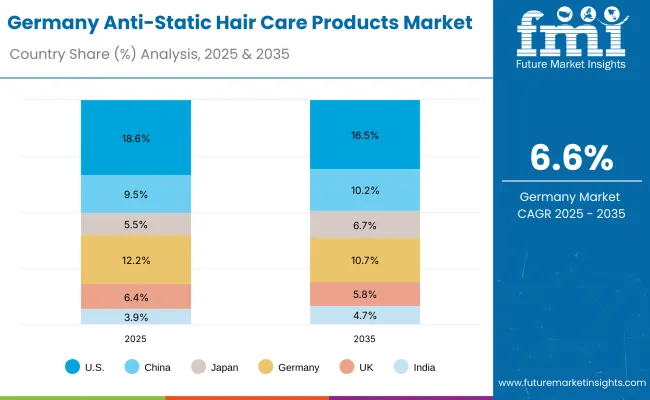
| Countries | 2025 Share (%) |
|---|---|
| USA | 18.6% |
| China | 9.5% |
| Japan | 5.5% |
| Germany | 12.2% |
| UK | 6.4% |
| India | 3.9% |
| Countries | 2035 Share (%) |
|---|---|
| USA | 16.5% |
| China | 10.2% |
| Japan | 6.7% |
| Germany | 10.7% |
| UK | 5.8% |
| India | 4.7% |
The Anti-Static Hair Care Products Market in Germany is projected to grow at a CAGR of 6.6% through 2035, driven by the nation’s mature personal care sector and its strong consumer focus on product safety, clean formulations, and environmental responsibility. German consumers exhibit high brand loyalty toward dermatologist-tested and silicone-balanced haircare solutions that combine efficacy with sustainability. The market benefits from a robust network of pharmacies, salons, and drugstore chains such as DM and Rossmann, which emphasize certified, eco-labeled anti-static products.
Local and regional manufacturers are innovating with biodegradable conditioning polymers, low-residue silicones, and sulfate-free surfactants, aligning with stringent EU cosmetic safety and packaging regulations. Demand is also supported by a growing preference for vegan, pH-balanced, and fragrance-free haircare designed for sensitive scalps and dry European climates. Germany remains a strategic export hub for clean-beauty haircare products, reinforcing its position as one of Europe’s most sophisticated and sustainability-driven markets.
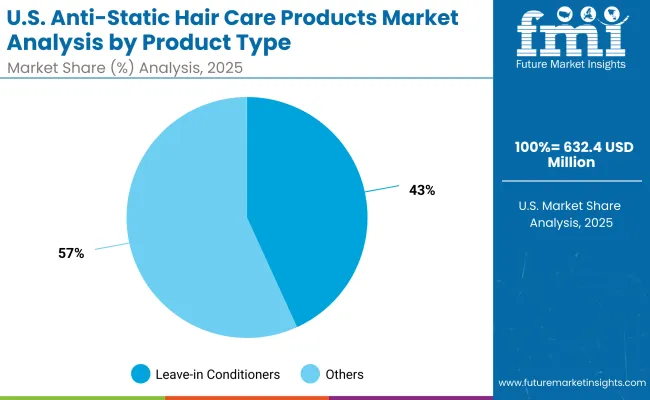
| USA By Product Type | Value Share% 2025 |
|---|---|
| Leave-in conditioners | 43.2% |
| Others | 56.8% |
The Anti-Static Hair Care Products Market in the United States is valued at USD 632.4 million in 2025 and is expected to grow steadily at a CAGR of 7.8% through 2035, reaching nearly USD 1.29 billion. Leave-in conditioners continue to dominate, capturing 43.2% of total market share, reflecting strong consumer preference for lightweight, long-lasting frizz control and hair smoothness.
This growth trajectory is reinforced by a shift toward data-driven product personalization and digital beauty ecosystems. Brands are increasingly leveraging AI-powered tools for product recommendation and customer profiling, helping consumers identify optimal formulations for their hair type and climate conditions. Premiumization trends are evident in professional salon brands emphasizing silicone-balanced, sulfate-free, and botanical-infused formulations that deliver both performance and scalp comfort.
As digital engagement deepens, subscription-based distribution models and online diagnostics are expanding recurring revenue potential for leading brands. The combination of clean-beauty innovation, personalized formulations, and omni-channel retail integration is set to define the competitive evolution of the USA Anti-Static Hair Care Products Market through 2035.
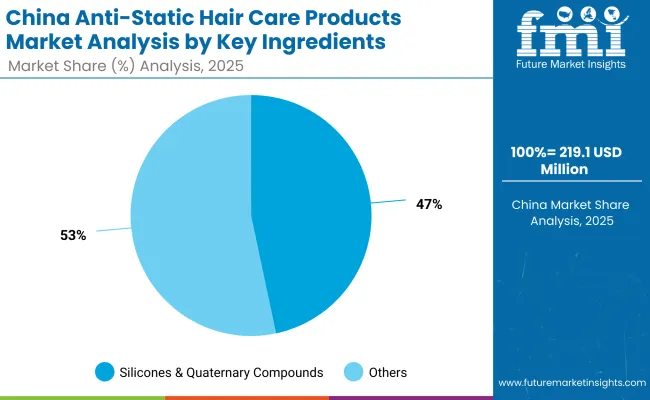
| China By Key Ingredients | Value Share% 2025 |
|---|---|
| Silicones & quaternary compounds | 46.7% |
| Others | 53.3% |
The Anti-Static Hair Care Products Market in China is projected at USD 219.1 million in 2025, expanding at a CAGR of 13.6% through 2035 the highest among major global markets. The country’s growth potential stems from the convergence of premium beauty consumption, ingredient localization, and digital retail transformation. Silicone and quaternary compound-based formulations hold 46.7% share, driven by their proven anti-frizz and conditioning performance suited to China’s humid climate zones.
Emerging opportunities are concentrated in clean-beauty and botanical product lines, where consumers are shifting toward sustainable, plant-based alternatives such as argan and camellia oils. The government’s push for green manufacturing and eco-labeled cosmetics is also encouraging local companies to innovate with biodegradable and low-residue silicone substitutes.
Moreover, cross-border e-commerce platforms such as Tmall Global and Douyin are redefining brand access, enabling domestic and international brands to reach urban Gen-Z consumers directly. The growing middle-class preference for science-backed, dermatologist-tested, and tech-integrated haircare solutions presents a sizable revenue opportunity.
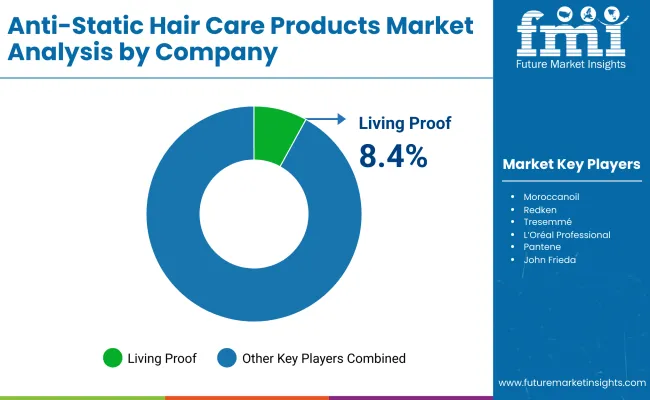
| Companies | Global Value Share 2025 |
|---|---|
| Living Proof | 8.4% |
| Others | 91.6% |
The Anti-Static Hair Care Products Market is moderately fragmented, comprising global beauty leaders, professional salon brands, and niche clean-beauty innovators. Major players such as Living Proof, L’Oréal Professional, and Moroccanoil hold significant shares, driven by advanced formulations combining silicones, quaternary compounds, and botanical oils to deliver anti-frizz performance and lasting smoothness. Their strategies increasingly emphasize research-based ingredient development, scalp health optimization, and eco-certified packaging.
Mid-sized brands like John Frieda, Tresemmé, and OGX are enhancing accessibility through hybrid retail and e-commerce channels, focusing on affordable yet high-quality conditioning and anti-static ranges. These companies are leveraging consumer data analytics and social media engagement to capture younger demographics.
Niche and emerging players such as boutique clean-beauty labels and vegan-certified startups are differentiating through silicone-free, sulfate-free, and pH-balanced products targeting sensitive scalp consumers. Customization, sustainability, and product transparency remain their key competitive levers.
The market’s competitive edge is shifting from pure product performance to holistic brand ecosystems, integrating personalized recommendations, digital diagnostics, and recurring subscription models. As sustainability and clean-label standards continue to evolve, players capable of blending science-backed efficacy with natural ingredient integrity are expected to lead the next phase of market consolidation.
Key Developments in Anti-Static Hair Care Products Market
| Item | Value |
|---|---|
| Quantitative Units | USD 2,306.5 Million |
| Product Type | Leave-in conditioners, Anti-frizz serums, Static-control sprays, Moisturizing shampoos & conditioners |
| Key Ingredients | Silicones & quaternary ammonium compounds, Argan oil & botanical oils, Protein complexes |
| Hair Type | Fine & thin, Curly & wavy, Color-treated |
| Channel | Salons & professional stores, E-commerce, Supermarkets & hypermarkets, Pharmacies |
| End User: | Women, Men, Unisex |
| Regions Covered | North America, Europe, Asia-Pacific, Latin America, Middle East & Africa |
| Country Covered | United States, Canada, Germany, France, United Kingdom, China, Japan, India, Brazil, South Africa |
| Key Companies Profiled | Living Proof, Moroccanoil, Redken, Tresemmé, L’Oréal Professional, Pantene, John Frieda, Aveda, Kerastase, OGX |
| Additional Attributes | Dollar sales by product type and hair concern, adoption trends across salon professionals and retail consumers, rising demand for lightweight and multifunctional anti-frizz formulations, sector-specific growth in personal grooming, professional salon services, and e-commerce beauty platforms, revenue segmentation by ingredient category (silicone-based, botanical, and protein-infused), integration with AI-driven personalization and virtual try-on technologies, regional trends influenced by climate conditions and beauty digitalization, and innovations in silicone alternatives, quaternary conditioning compounds, and sustainable botanical blends for enhanced static-control performance. |
The global Anti-Static Hair Care Products Market is estimated to be valued at USD 2,306.5 million in 2025.
The market size for the Anti-Static Hair Care Products Market is projected to reach USD 5,306.7 million by 2035.
The Anti-Static Hair Care Products Market is expected to grow at a 8.7% CAGR between 2025 and 2035.
The key product types in the Anti-Static Hair Care Products Market are leave-in conditioners, anti-frizz serums, static-control sprays, and moisturizing shampoos & conditioners.
In terms of hair type, the fine & thin hair segment is projected to command a significant share of 38.1% in the Anti-Static Hair Care Products Market in 2025.






Our Research Products

The "Full Research Suite" delivers actionable market intel, deep dives on markets or technologies, so clients act faster, cut risk, and unlock growth.

The Leaderboard benchmarks and ranks top vendors, classifying them as Established Leaders, Leading Challengers, or Disruptors & Challengers.

Locates where complements amplify value and substitutes erode it, forecasting net impact by horizon

We deliver granular, decision-grade intel: market sizing, 5-year forecasts, pricing, adoption, usage, revenue, and operational KPIs—plus competitor tracking, regulation, and value chains—across 60 countries broadly.

Spot the shifts before they hit your P&L. We track inflection points, adoption curves, pricing moves, and ecosystem plays to show where demand is heading, why it is changing, and what to do next across high-growth markets and disruptive tech

Real-time reads of user behavior. We track shifting priorities, perceptions of today’s and next-gen services, and provider experience, then pace how fast tech moves from trial to adoption, blending buyer, consumer, and channel inputs with social signals (#WhySwitch, #UX).

Partner with our analyst team to build a custom report designed around your business priorities. From analysing market trends to assessing competitors or crafting bespoke datasets, we tailor insights to your needs.
Supplier Intelligence
Discovery & Profiling
Capacity & Footprint
Performance & Risk
Compliance & Governance
Commercial Readiness
Who Supplies Whom
Scorecards & Shortlists
Playbooks & Docs
Category Intelligence
Definition & Scope
Demand & Use Cases
Cost Drivers
Market Structure
Supply Chain Map
Trade & Policy
Operating Norms
Deliverables
Buyer Intelligence
Account Basics
Spend & Scope
Procurement Model
Vendor Requirements
Terms & Policies
Entry Strategy
Pain Points & Triggers
Outputs
Pricing Analysis
Benchmarks
Trends
Should-Cost
Indexation
Landed Cost
Commercial Terms
Deliverables
Brand Analysis
Positioning & Value Prop
Share & Presence
Customer Evidence
Go-to-Market
Digital & Reputation
Compliance & Trust
KPIs & Gaps
Outputs
Full Research Suite comprises of:
Market outlook & trends analysis
Interviews & case studies
Strategic recommendations
Vendor profiles & capabilities analysis
5-year forecasts
8 regions and 60+ country-level data splits
Market segment data splits
12 months of continuous data updates
DELIVERED AS:
PDF EXCEL ONLINE
Professional Hair Care Market Insights & Forecast 2025 to 2035
Demand for Professional Hair Care Products in USA Size and Share Forecast Outlook 2025 to 2035
Demand for Professional Hair Care Products in Japan Size and Share Forecast Outlook 2025 to 2035
Haircare Supplement Market - Size, Share, and Forecast Outlook 2025 to 2035
Hair Care Market Size and Share Forecast Outlook 2025 to 2035
Hair Care Packaging Market Growth and Trends 2025 to 2035
Suncare Products Market Size and Share Forecast Outlook 2025 to 2035
Skincare Products Market Size and Share Forecast Outlook 2025 to 2035
Sun Care Products Market Analysis – Growth, Applications & Outlook 2025–2035
Car Care Products Market Trends - Growth, Demand & Analysis 2025 to 2035
Hair Styling Products Market Analysis - Trends, Growth & Forecast 2025 to 2035
Nail Care Products Market Growth, Trends and Forecast from 2025 to 2035
Hair Lightening Products Market Size and Share Forecast Outlook 2025 to 2035
Facial Care Products Market Size and Share Forecast Outlook 2025 to 2035
Dental Care Products Market Size and Share Forecast Outlook 2025 to 2035
Hair Loss Prevention Products Market Size and Share Forecast Outlook 2025 to 2035
Personal Care Products Filling System Market Size and Share Forecast Outlook 2025 to 2035
The Dementia Care Products Market is segmented by Memory Exercise & Activity Products, Daily Reminder Products and Dining Aids from 2025 to 2035
Men’s Skincare Products Market Size, Growth, and Forecast for 2025 to 2035
Pregnancy Care Products Market Analysis - Size, Share, and Forecast Outlook 2025 to 2035

Thank you!
You will receive an email from our Business Development Manager. Please be sure to check your SPAM/JUNK folder too.
Chat With
MaRIA